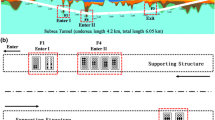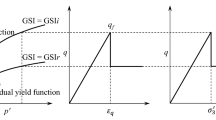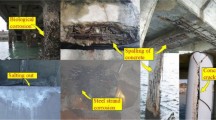Abstract
The construction and protection of tunnels in karst areas face many difficulties and challenges. The Wulong tunnel, which is located in a karst area in Southwest China, was s elected as an case study to analyze and evaluate the corrosion of tunnel rock under different environmental conditions. A series of field and laboratory experiments aimed at studying the impact of temperature and flow rate on tunnel rock corrosion was conducted, and the results were analyzed in terms of total corrosion amount, corrosion rate, and the features and mechanisms of the chemical and physical corrosion processes. The key factors affecting the chemical and physical corrosion processes were also determined. A mathematical expression for the corrosion rate as a function of the flow rate and temperature was constructed from the experimental results, and this mathematical model was then used to analyze tunnel rock corrosion under field environmental conditions.





















Similar content being viewed by others
References
Adamczyk K, Premont-Schwarz M, Pines D, Pines E, Nibbering ETJ (2009) Real-time observation of carbonic acid formation in aqueous solution. Science 326:1690–1694
Arvidson RS, Fischer C, Luttge A (2015) Calcite dissolution kinetics. Aquat Geochem 21:415–422
Buhmann D, Dreybrodt W (1987) Calcite dissolution kinetics in the system H2O-CO2-CaCO3 with participation of foreign ions. Chem Geol 64:89–102
Busenberg E, Plummer LN (1985) Kinetic and thermodynamic factors controlling the distribution of SO3 2−, and Na+, in calcites and selected aragonites. Geochim Cosmochim Acta 49:713–725
Cubillas P, Köhler S, Prieto M, Causserand C, Oelkers EH (2005) How do mineral coatings affect dissolution rates? An experimental study of coupled CaCO3 dissolution—CdCO3precipitation. Geochim Cosmochim Acta 69:5459–5476
Dreybrodt W (1996) Principles of early development of karst conduits under natural and man-made conditions revealed by mathematical analysis of numerical models. Water Resour Res 32:2923–2935
Eisenlohr L, Meteva K, Gabrovšek F, Dreybrodt W (1999) The inhibiting action of intrinsic impurities in natural calcium carbonate minerals to their dissolution kinetics in aqueous H2O–CO2 solutions. Geochim Cosmochim Acta 63:989–1001
Finneran DW, Morse JW (2009) Calcite dissolution kinetics in saline waters. Chem Geol 268:137–146
Fischer C, Kurganskaya I, Schäfer T, Lüttge A (2014) Variability of crystal surface reactivity: what do we know? Appl Geochem 43:132–157
Furlani S, Cucchi F, Forti F, Rossi A (2009) Comparison between coastal and inland karst limestone lowering rates in the northeastern adriatic region (Italy and Croatia). Geomorphology 104(1):73–81
Gledhill DK, Morse JW (2006) Calcite dissolution kinetics in Na–Ca–Mg–Cl brines. Geochim Cosmochim Acta 70:5802–5813
Gong Q, Deng J, Wang Q, Yang L, Min S (2010) Experimental determination of calcite dissolution rates and equilibrium concentrations in deionized water approaching calcite equilibrium. J Earth Sci 21:402–411
Gutiérrez F, Parise M, Waele JD, Jourde H (2014) A review on natural and human-induced geohazards and impacts in karst. Earth Sci Rev 138:61–88
Jeschke AA, Dreybrodt W (2002) Pitfalls in the determination of empirical dissolution rate equations of minerals from experimental data and a way out: an iterative procedure to find valid rate equations, applied to ca-carbonates and-sulphates. Chem Geol 192:183–194
Lasaga AC (2014) Kinetic theory in the earth sciences. Princeton University Press, Princeton
Lasaga AC, Lüttge A (2004) Mineralogical approaches to fundamental crystal dissolution kinetics. Am Mineral 89:527–540
Li CS, Gao B, Mei ZR (2013) Karst and groundwater advance prediction techniques. Southwest Jiaotong University Press, Chengdu (in Chinese)
Lüttge A (2006) Crystal dissolution kinetics and Gibbs free energy. J Electron Spectrosc Relat Phenom 150:248–259
Marinos PG (2001) Tunnelling and mining in karstic terrain: an engineering challenge. In: Beck BF, Herring JG (eds) Geotechnical and environmental applications of karst geology and hydrology. Balkema Publishers, Lisse, pp 3–16
Milanovic P (2002) The environmental impacts of human activities and engineering constructions in karst regions. Episodes 25:13–21
Morse JW, Arvidson RS (2002) The dissolution kinetics of major sedimentary carbonate minerals. Earth Sci Rev 58:51–84
Morse JW, Berner RA (1972) Dissolution kinetics of calcium carbonate in sea water: II. A kinetic origin for the lysocline. Am J Sci 272:840–851
Palma B, Ruocco A, Lollino P, Parise M (2012) Analysis of the behaviour of a carbonate rock mass due to tunneling in a karst setting. In: Han KC, Park C, Kim JD, Jeon S, Song JJ (eds) The present and future of rock engineering (Proc 7th Asian Rock Mechanics Symp, October 15–19. Seoul, pp 772–781
Parise M, Closson D, Gutiérrez F, Stevanović Z (2015) Anticipating and managing engineering problems in the complex karst environment. Environ Earth Sci 74(12):7823–7835
Plummer LN, Busenberg E (1982) The solubilities of calcite, aragonite and vaterite in CO2-H2O solutions between 0 and 90°C, and an evaluation of the aqueous model for the system CaCO3-CO2-H2O. Geochim Cosmochim Acta 46:1011–1040
Pokrovsky OS, Golubev SV, Schott J (2005) Dissolution kinetics of calcite, dolomite and magnesite at 25°C and 0 to 50 atm pCO2. Chem Geol 217:239–255
Pokrovsky OS, Golubev SV, Schott J, Castillo A (2009) Calcite, dolomite and magnesite dissolution kinetics in aqueous solutions at acid to circumneutral pH, 25 to 150°C and 1 to 55 atm pCO2: new constraints on CO2 sequestration in sedimentary basins. Chem Geol 265:20–32
Qingjie G, Jun D, Qingfei W, Liqiang Y, Min S (2008) Calcite dissolution in deionized water from 50°C to 250°C at 10 MPa: rate equation and reaction order. Acta Geol Sin (Engl Edn) 82:994–1001
Shiraki R, Brantley SL (1995) Kinetics of near-equilibrium calcite precipitation at 100°C: an evaluation of elementary reaction-based and affinity-based rate laws. Geochim Cosmochim Acta 59:1457–1471
Stephenson WJ, Finlayson BL (2009) Measuring erosion with the micro-erosion meter - contributions to understanding landform evolution. Earth-Sci Rev 95(1):53–62
Svensson U, Dreybrodt W (1992) Dissolution kinetics of natural calcite minerals in CO2-water systems approaching calcite equilibrium. Chem Geol 100:129–145
Xu J, Fan C, Teng HH (2012) Calcite dissolution kinetics in view of Gibbs free energy, dislocation density, and pCO2. Chem Geol 322:11–18
Yu HD, Yang D, Wang D, Han MY (2010) Top-down fabrication of calcite Nano shoot arrays by crystal dissolution. Adv Mater 22:3181–3184
Zhang XH, Liu QW (2005) Analysis of the features of water outbursts from underground rivers and the countermeasures in Wulong tunnel. Modern Tunnelling Technology 42:59–64 (in Chinese)
Zhao YJ, Wang FG, Li CS, Wu FS, Cao YQ (2016) Carbonate karst Erosion experiment research of Guizhou Huangguoshu tunnel. Coal Technology 35(7):310–312 (in Chinese)
Zhou W, Beck BF (2011) Engineering issues on karst. In: van Beynen P (ed) Karst management. Springer, Dordrecht, pp 9–45
Zhu WH, Qu XY, Qiu LW, Chen Y, Gong FX, Wu SX (2015) Characteristics and erosion mechanism of carbonate in acetic acid and hydrochloride solutions: an example from the Nanpu depression. Bull Mineral Petrol Geochem 34:619–625 (in Chinese)
Acknowledgments
This study was supported by the China Geological Survey Project (No. DD20189504-18-4;DD20160229-w03;), by the Graduate Innovation Fund of Jilin University (No. 2017148) and by the National Natural Science Foundation of China (No. 41372334). The paper also supported by Jilin Provincial Key Laboratory of Water Resources and Environment, Jilin University.
Author information
Authors and Affiliations
Corresponding author
Ethics declarations
Conflicts of interest
The authors declare no conflict of interest.
Rights and permissions
About this article
Cite this article
Wang, F., Zhao, Y., Li, C. et al. An experimental study on the corrosion characteristics of the karst tunnel engineering area in Southwest China. Bull Eng Geol Environ 78, 4047–4061 (2019). https://doi.org/10.1007/s10064-018-1411-6
Received:
Accepted:
Published:
Issue Date:
DOI: https://doi.org/10.1007/s10064-018-1411-6




